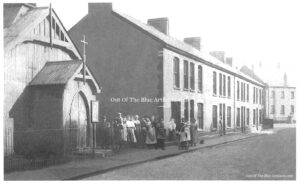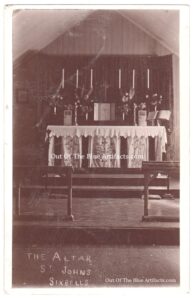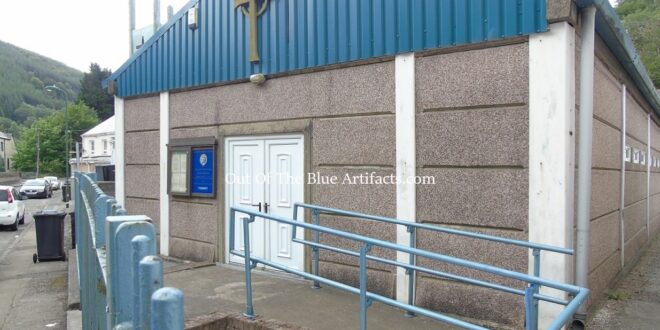St John’s Church Six Bells.
In the early 1900’s the Anglican Church held meetings and Rev D. Felix, the rector of Llanhilleth had conducted services at the Six Bells School.
In February 1905 it was reported in the Parish Magazine that a loan of £1,200 had been negotiated and the vicar Rev H. S. Rees was able to proceed with the erection of a chancel, vestries and side chapel to an existing nave? The documents had been fully signed and it was stated that within the next six weeks the work of erecting the St John’s Church, Six Bells would commence.
I don’t think this project was put into motion as it was reported to have been planned to build “onto an existing” nave and at a cost of £1,200. It was later reported that the reverend had decided to have an iron structured church built at half the cost. The original planned, proposed church may have been in a different location?
 The Official Opening of the Church.
The Official Opening of the Church.
On Monday 10th of April 1905, the St John’s Church was officially opened. The Rev D. Felix had acquired land from the Hanbury Estate and Messrs J. Lancaster & Co. The site for the church was on a small piece of ground (as seen left) between Arrail Street and River Row (later re-named Griffin Street) close to the Six Bells Miners Institute. The dedication service started at 8.30am with the celebration of the Holy Communion with the preacher being Rev E. Morgan B.A of Trevethin and in the afternoon a special dedicatory service was held with the Rev J. L. Croft of Cwm as the preacher. On the following Tuesday 11th April Rev Owen Davies of Blaina preached and in the afternoon service baptisms took place.
The Contractor and Architect.
The contractors were Messrs Humphries of Knightsbridge, West London.
 Description of the Building.
Description of the Building.
As mentioned, the Rev D. Felix decided to go for the option of having an iron structured church. The church was built to accommodate 300 people and the construction cost £600. At the time of completion £175. had been raised. Mr C. Hales of Hitchen gave a handsome font and other gifts towards the furnishings.
In May 1905 it was reported in the Parish Magazine that Mr Edwin Price of Somerset Street, Abertillery had presented a complete set of alter linens to the church at Six Bells and the vicar had received a letter concerning the organ that was in use at the church. The letter read ” This organ was presented to St John’s Church by the sidesmen of the Six Bells Mission on behalf of the mission and with the approval of the rector of Llanhilleth”. Messrs G. Lewis; J. Legge; D. Phillips and J. Morgan being the sidesmen.
The Interior of the Church.
The original interior and alter can be seen (right).
The Memorial Shrine.
On Sunday 3rd of April 1932, Major T. Stanley Richards M.C., M.E., unveiled a memorial shrine to the ten men of the church who fell in the Great War. The service was conducted by Rev A. K. Shrewsbury. The shrine was a gift of the Women’s Guild of St Johns Church and the vicar, it was placed in the entrance of the church. The shrine made by Mr R. G. Kidner, was a crucifix of light oak on a dark oak background with the names of the men on a brass plaque. The names of the fallen who were commemorated on the plaque were as follows – Mr Samuel Andrews; Mr Herbert Bowley; Mr Frederick Chorley; Mr John Thomas Davies; Mr Ernest Evans; Mr William Hodges; Mr Frederick Lewis; Mr George Treherne; Mr Ernest Viney and Mr Cyril Vaughan:
The Closure of the Old St John’s Church.
Towards the end of the 1960’s the old St John’s Church was deemed unfit for purpose and a new building was proposed.
The Last Service at the Old St John’s Church.
In October 1968 the last services were held in the church.
The New St Johns Church.
On Saturday 5th of April 1968, the new St John’s Church was officially opened by the Bishop of Monmouth. The Bishop’s precession included Ven Ivor Phillips the Archdeacon of Newport; Rev Ralph Bowden the Rural Dean of Blaenau Gwent and Rev E. G. L. Harbourn, the Vicar of Six Bells: At the service, an empty seat was kept vacant for the late Mrs Blodwen Davies, who after 31 years’ service to the church had sadly passed away during the renovations.
The First Wedding Ceremony.
The first wedding ceremony to be conducted at the new St John’s Church was that of Mr Alan Charles Nightingale and Miss Eileen Joyce Seabourne. Mr Nightingale was a Lance Corporal in the Royal Army Medical Corp. Miss Eileen Joyce Seabourne was the daughter of Mr and Mrs Edward and Jeanette Seaborne of Bryngwyn Road.
The Later Years.
St John’s Church, Six Bells is still in service today.
 Out Of The Blue Artifacts A Library of a lifetime of collecting
Out Of The Blue Artifacts A Library of a lifetime of collecting
